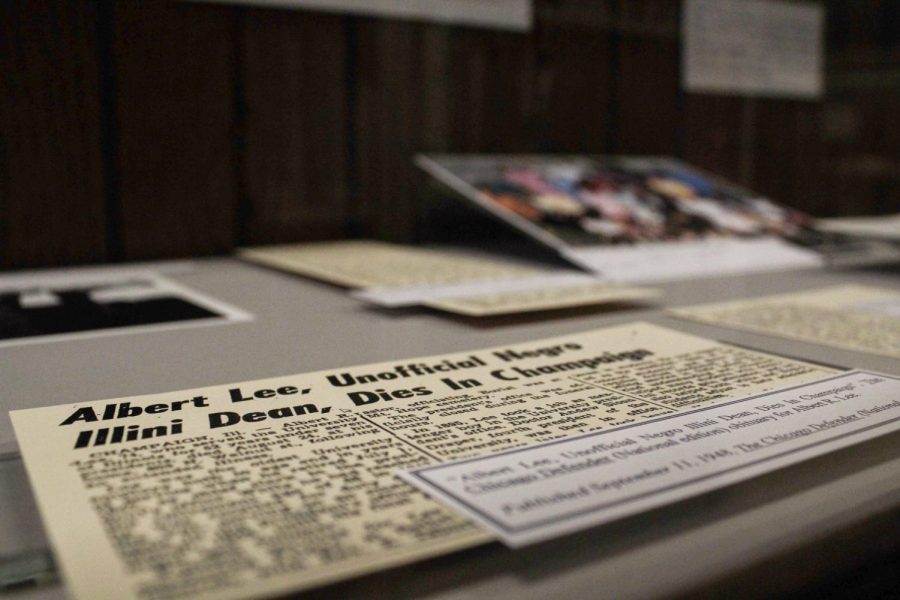Illinois Archives: hidden gems of the University’s rich history
An exhibit featuring Albert Lee and displaying some of his works was located in the Main Library Room 146 on Oct. 2nd, 2018.
Oct 3, 2018
Though students may frequent the Main Library every day, few seem to know the building is also home to the University of Illinois Archives, which hold thousands of records, manuscripts, photographs and other paraphernalia that keep Illinois’ history alive.
The Archives are divided into multiple collections, which all contain unique mementos that have been donated or contracted to the University for anyone to explore.
One of the most heavily used collections is the American Library Association (ALA) Archives, which attracts researchers from around the world.
William Maher, University archivist, describes the ALA as having been a professional advocacy group for librarians that has developed educational and technical standards for librarians.
Since it was founded in 1876, the ALA has been an advocate “in the public form for things like literacy education for immigrants and for freedom of expression. Especially, they’ve advocated against [the] censoring of books,” Maher said.
Get The Daily Illini in your inbox!
Another very notable collection often viewed is the Sousa Archives and Center for American Music, which houses John Philip Sousa’s performance library. This includes original manuscripts, historical instruments (which mainly consist of brass and wind) and even one of the batons used for conducting.
For those more attuned to literature, one can find a manuscript of “Johnny Panic and the Bible of Dreams,” submitted by American poet and novelist Sylvia Plath. This manuscript was submitted to a small, campus-based magazine called Accent in 1958.
Though one of Plath’s most famous works today, the editors of the magazine did not see its worth at the time, rejecting the poem for publication after making notes on the piece. Both the original manuscript and editors’ notes are stored in the Personal Papers and Manuscripts Collections.
One of Arthur N. Talbot’s journals is also featured in this collection. In this particular journal, he talks about the first telephone call he heard all the way from Urbana to Champaign.
New exhibits are always being formed, usually in regard to the climate of the campus. Recently created is the Albert Lee exhibit. Lee was an African American student that grew up in town and attended the University. He worked in the University president’s office as a messenger boy, later progressing to the title of Chief Clerk to the president.
Not only did he become a trusted advisor to the president, but he was also an advocate for his race during the time of de facto segregation, helping African American students find housing on campus.
Those more geared toward science can find interest in the recordings and papers of the microbiologist and biophysicist, Carl Woese, who was the subject of an exhibit this past Thursday at the Spurlock Museum.
There is a broad range of people who use the archives – from University faculty and students to scholars from around the world.
“Basically, if anybody has a question relating to the history of the University, we are the first source to turn to,” assistant University archivist Christopher Prom said.
The importance of the Archives is to shed light on fascinating documents and memorabilia that display the thoughts and principals of the eras.
“It’s all old documents, stuff that’s kind of static there, but it’s the connections that the documents show that is what the business is really about,” Maher said.
Ellen Swain, the archivist for Student Life and Culture, agrees with Maher about the significance of exposing readers to the past. Her job entails filtering through specifically student life and culture archives specifically.
“Connecting people to the material is probably my favorite part,” she said.
The University’s Student Life and Culture Collection is the only program in the country solely devoted to the history of student life and culture. Included in the collection are scrapbooks from sororities and fraternities, the first student-run newspaper predating The Daily Illini and even a student’s expense books from 1943 documenting every year he was in school.
“The majority of records that people use and that we have in the archives are just people who save things,” Swain said.
Any student or organization can donate their own records to the collection and potentially become a significant figure piece in the Archives for future generations to appreciate.
Since it was established in 1963, the University Archives continue to grow every day with new materials, adding to the extensive array of University history. People can easily access these fascinating records and see firsthand accounts of history distinctive from anywhere else in the world.
“You find these little pieces of history, and it’s really fascinating and fun just to hold that in your hand,” Prom said. “You know this was by someone who really changed history.”






